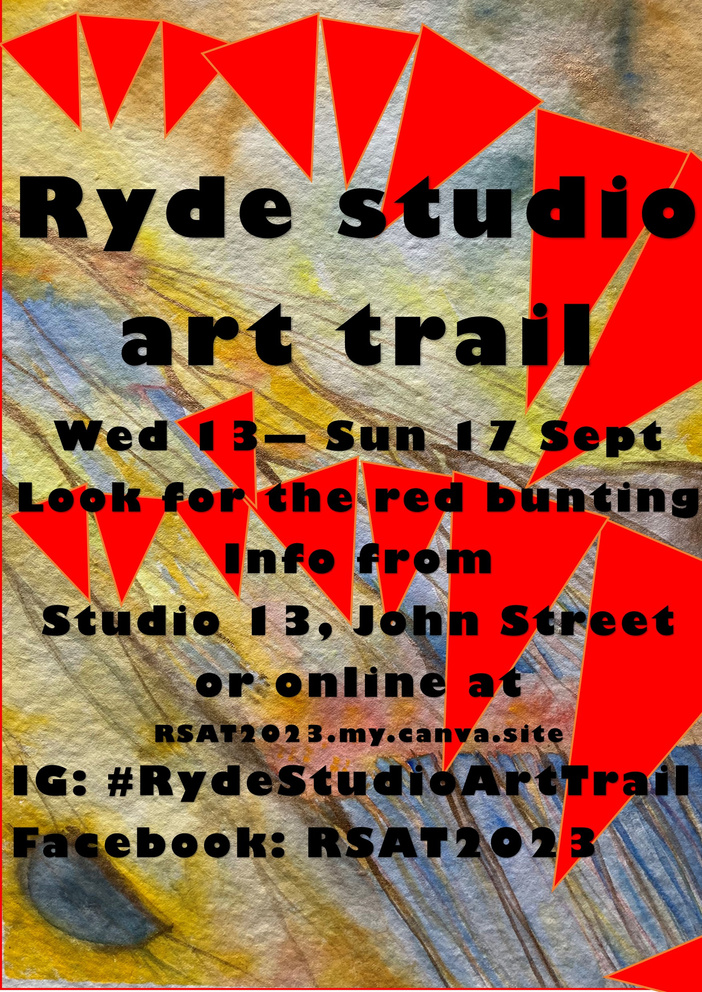
Pick up a trail guide at Studio 13, John St., Ryde, PO33 2PY and enjoy artist interviews by Rosemary Lawrey and Grant Bull below
See map and artist profiles below
Ryde Studio Art Trail
13 - 17 September 2023
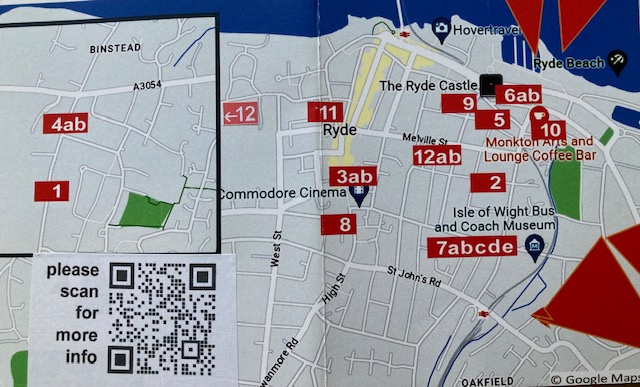
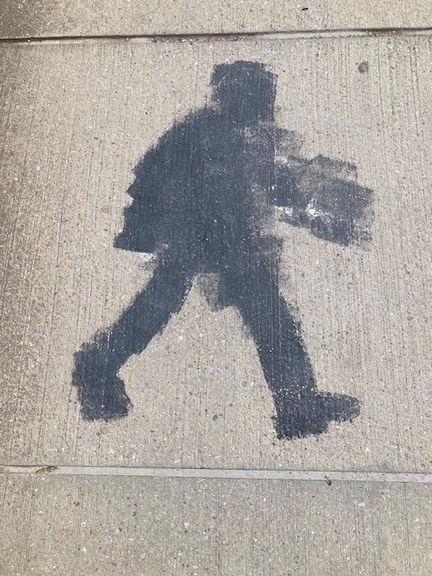
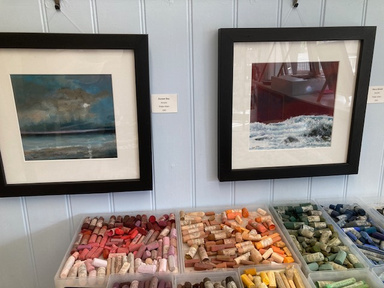
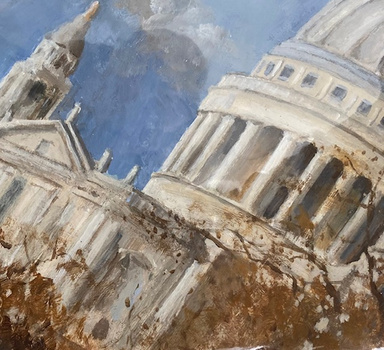
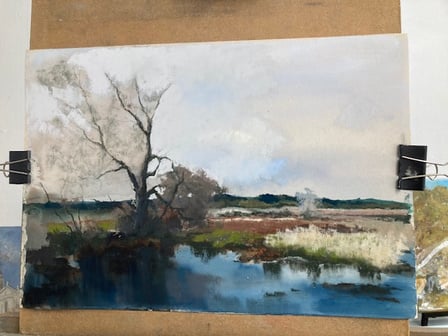
Peter Allen
When you walk up Ryde High Street, take a detour right into John Street and pay a visit to Studio 13. This is the birthplace of the Ryde Studio Art Trail, brainchild of artists Peter Allen and Lyndy Moles. There you can pick up an Art Trail flyer with a map giving details and whereabouts of all artists on the trail this September.
Peter Allen, Studio 13, John Street, Ryde, PO33 2PY, Tel: 01983 616182
Keeping things soft and beautiful
Peter has been drawing and painting “forever” and his commitment to his work is evident, not only in the exquisite array of landscapes in his half of Studio 13, but also the stacks of plein air sketchbooks and trays of scattered visual notes he has tucked away. It is a joy to rifle through these and come up with treasures: among them some exquisite postcard-sized watercolours, painted on handmade khadi paper.
Working outdoors is a vital aspect of Peter’s work, and it is this direct connection with his subject that gives his paintings their spontaneity and vibrancy. A look around his studio will give an insight into Peter’s travels, which are far and wide. There are plenty of views of favourite Isle of Wight spots, Spring Vale, the view to the fort at Seaview, St Helen’s Duver, looking back to the island from Southsea, Compton Bay, the cliffs below Tennyson Down, interspersed with temples in Greece and Turkey, and a beautiful series of three paintings of “a muddy spot in the New Forest”. Peter goes out sketching and painting both alone and with the Isle of Wight Art Club, and takes his artist’s materials wherever he goes. It isn’t always possible to pack an easel and paints, but Peter has an impressive ability to depict enough of a scene in three or four pencil lines for him to re-create both scene and atmosphere later in the studio. “I don’t make colour notes” says Peter, “it’s all about form and composition”, once he has noted down the shapes, he can return to the studio, and “change the weather” with colours that suit his mood. One moment, expertly captured in a few strokes at one of his favourite Island spots, fuelled 30 studio paintings, all of which have been snapped up by collectors.
Peter’s extraordinary visual memory reminded me of abstract painter Joan Mitchell saying “I carry my landscapes around with me”. “Yes,” said Peter, that’s exactly what I do, but it’s the skies more than anything that I carry in my head, after all, the most interesting landscapes are two-thirds or three-quarters sky”.
Such feats of memory must be explained, in part by Peter’s attention to detail, and the study he devotes to his surroundings. He described to me the gorgeous golden colour of the grass at St Helens that had been allowed to grow long during the Covid pandemic restrictions. Here he stood in one spot, recording the scene in four different directions.
If Peter is well travelled, people also come from far and wide to visit him. He described to me with amusement how one lady from America just had to have a large framed work of his, determined to fit it in her suitcase for the flight home, no matter what else had to be left behind to make room for it.
Peter’s work is soft, still and gentle. Yet movement is obviously important to him too. When he doesn’t feel like going anywhere himself, he has been known to sit at the bus station, watching others travel, and sketching the passers-by.
It is obvious that Peter finds his joy in the natural world and his main interest is in organic shapes and textures rather than buildings, but he is an active member of the London Plein Air group. He finds working in an urban context a very “good discipline in perspective, but the natural is always present.” It is a tree that features large in the foreground of his very fine plein air painting of St Paul’s cathedral, for example, sketched from a quiet corner of a little park.
My favourite memories of Peter’s studio: meandering waters at St Helens Duver in gentle green colours, a moody glimpse of castle wall painted from Carisbrook Priory, and the acrylic and pastel painting currently undergoing work on his easel. Go and pay Peter a visit and take a look. I can guarantee it will be an informative experience. Perhaps you will walk out the door, just as I did, uplifted and with a keen new excitement and appreciation of nature’s influence on the world around us. - R.L.
Studio 13 is open every Wednesday to Saturday and every day during Ryde Studio Art Trail, 13 – 17 September, 10 am – 4pm.
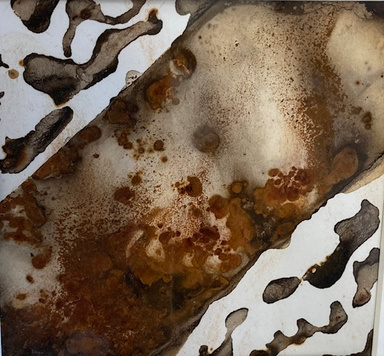
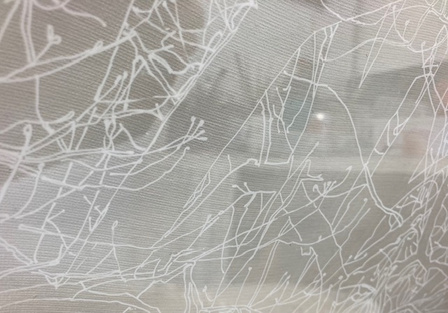
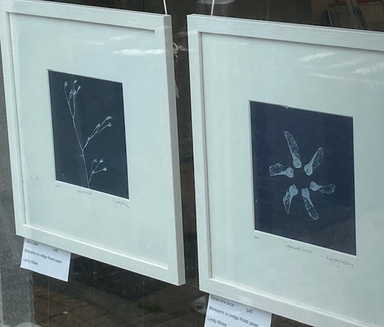
Lyndy Moles
Lyndy Moles, Studio 13, John Street, Ryde, PO33 2PY, www.lyndy@lyndymoles.co.uk
Rust is alchemy
Lyndy likes to concentrate the gaze of anyone who views her artwork, negating the very busy visual world we now inhabit, if eyes are darting all over the place, people lose the ability to really look. Lyndy achieves this by a combination of reduction, repetition and clean lines. Her “1500 horizons”, for example, in indigo watercolour, is an encapsulation of many views of the same scene in the ever-changing Solent light, pared down into a series of simple, isolated horizontal strokes approximately 2 cm across, to breathtaking effect. So simple, yet one could look at it for a very long time without seeing everything there is to see.
Much of Lyndy’s work is monochrome, some is in rust, and a great deal of it is in white alone. These are intricate white line drawings onto acrylic glass, raised against a white background. The effect is a delicate, dancing lacework of reflections, highlights and shadows. That delicacy and luminosity is a feature of everything Lyndy does, from her prints on white and indigo khadi paper to etchings and artworks created using the beautiful patinas of rust. Her side of studio 13 makes a crisp contrast with the colourful pastel and painted landscapes of Peter Allen in the next room. Yet there are splashes of colour in Lyndy’s studio too, and a sense of play and fun running through everything. This humour is most obvious in Lyndy’s inexpensive but irresistible hand-made Isle of Wight souvenirs in the shape of exquisite concertina books, notebooks and memory boxes (Ryde agamographs), blizzard book folds with hand-printed seashore tags - artworks to which the owner can add their own creative spark.
Although it is the natural world that inspires all Lyndy’s art, there is a very distinctive technical element and a spark of ingenuity in everything Lyndy makes. Lyndy is attracted to the mathematical, though she has not studied technical drawing, she has a natural flair for careful planning and design. “I don’t have sketchbooks really – my sketchbooks are full of dimensions and plans”. Planning, much experimentation and technical acuity have resulted in some ingenious works of art and many that are just plain stunning in their simplicity.
Accessibility is very important to Lyndy. She confesses to having been thrown out of art galleries for touching the artworks, and so she wants her own work to appeal not just to the visual senses. She described to me a walk-through touchable installation she had made for her BA, including gravel on the floor which crunched when walked on, to appeal to the sense of hearing as well as touch. She has done much research in the past on making artwork available to the visually impaired, incorporating braille and exploring and experimenting with answers to the question “How do blind people see?”.
Sculpture too is an element of Lyndy’s practice. When I visited her studio, she had fashioned a boxful of ivy leaves out of clay. She planned to use them to cover a figure which would also incorporate drawings on glassine paper tucked into it referencing the importance of ivy as a habitat and resource for over 50 species. I asked Lyndy what she tends to think about while she is working. “The other stuff behind the artwork, I think about the tangential stuff, about making connections,” she replied. “For example, in the case of the ivy, possible links with witches, healing herbs, is there a goddess of ivy? What is her name?” The questions and associations are endless, “But even if I do go down a rabbit hole, I know that everything will come back out again at some point”. I am also constantly thinking of how you would make something into something else” – oak galls into ink, for example, or a rusty old key into a moody monotype print. “I have collections of little bottles containing oak galls, insects, shells, seaweed, fungi, all sorts of finds from the natural world. Rust is another natural process, enabling the viewer to see things in line and form”. Lyndy eliminates visual overload and she has fun doing it. “Rust is alchemy” she says. - R.L.
Studio 13 is open every Wednesday to Saturday and every day during Ryde Studio Art Trail, 13 – 17 September, 10 am – 4pm.


Rosie Sirkett
Human connections
I first got to know Rosie Sirkett in the cafe at Yelf’s hotel. She had tricked me into meeting her there for tea. Little did I know that Rosie had an ulterior motive. She wanted to photograph me and paint my portrait. Cameras love me not at all, so I was, to say the least, horrified at the prospect. To my surprise, both the photograph Rosie took and the painting she subsequently made from it were lovely. With vibrant colour and angular abstract shapes, she had captured my personality in textured oil pastels, and I was delighted with the result.
When she is unable to find a sitter to draw from life, Rosie scours fashion websites for models to practise on - interesting faces which she will transform icon-style, or halo with space helmets, transforming them into futuristic saints, changing personalities with abstract elements. Symbolism is a feature of Rosie’s work – a pastel slash across a chin or cheekbone will hint at a spiritual sign.
Rosie finds other sources for her work in old photos snapped during travels – chin-deep in water with praying hands, wandering through a farmyard with two buckets, back to the camera, at a fancy-dress party in the 1980s. Rosie is attracted to the candid view rather than the posed.
Inspired by Larry Stanton, an artist friend of David Hockney who made a series of portraits of beautiful men, she has begun her own series of androgenous faces. She is also interested in creating nurturing, “mother” portraits. For Rosie, art should be a safe emotional space for the viewer - a space in which to process difficult emotions and in which to nurture the positive ones. So she aspires to evoke emotions in the viewer, and to encourage the viewer to allow themselves to experience these.
Rosie has explored concepts in both sculpture and paint that are much more abstract than her portraits. She may well take the portraiture into another dimension and is planning initially to experiment with the creation of a small head in polymer clay. For her, abstraction has been a way of exploring the need that exists for restraint in the world, and the desirability of not always seeing the full picture. “I observed, for instance, a need in me to reach for the phone at all times and find out information, but actually not everything does need to be found out instantly.” The abstract, however, hasn’t excited Rosie as much as her portraiture work. She has realised that what is important is doing the things that she as an artist is passionate about. “I struggle to create something I would like to hang on my own wall”, she says. “I wouldn’t actually choose to buy a portrait myself. It would feel intrusive – I don’t like the idea of a portrait being on my wall – but, paradoxically, it is the type of art I love to paint and draw.”
The eyes are the feature that Rosie is most attracted to, whether searching for a subject in real life or online. “Something magical happens when you fill in the eyes…creating a portrait, it’s like creating life!” she says. “When I wake up in the morning and see a face I’ve been working on, I’m so excited by the feeling it gives me – I guess it’s something to do with the need for human connections.” “I almost want to paint just the eyes” she says.
That pull towards abstraction is still there. We sat together and looked at some images from “The Other Art Fair”. I was struck that it was the simplest of forms that drew Rosie in most, and fired up her senses. I wonder where that sharp-edged vision of hers will lead her next. - R.L.
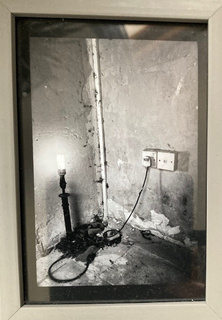
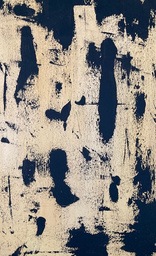

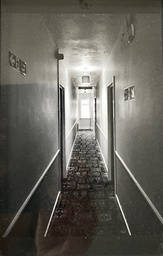

Grant Bull
Finding beauty in the imperfect
Mysterious monochrome striations on canvas, a photograph of what was once a car seat, now decomposed to its springs, stark scenes of abandonment - Grant Bull’s stirring digital black and white photography and abstract paintings are his intellectual and emotional response to a world that is beautiful in its imperfection. It is a joyous response, tinged with the melancholic. Joy because signs of decay are signs of life – signs that things have happened here, both natural and human processes and histories. Living on the Isle of Wight, Grant finds himself surrounded by architectural links to the past. He enjoys the questions such relics raise in his mind. “If it isn’t left behind, if everything is smartened up and new, then we have no trace.” Grant grew up in South London, and he feels the absence of graffiti on the walls here. “Something is missing…”, yet urban expression is not altogether absent, and he identifies it in other aspects of the Island. “Hardly any two houses are the same in Ryde”, he says “I love the mix of different eras between buildings. There is a mismatch in the skyline that is very appealing”. This holding on to reminders of what was there before is reflected too in some of Grant’s choices of media. He has repurposed some old artworks from the charity shop. Sometimes the ghosts of a former painting are still visible through the back of the canvas, adding a new and fascinating dimension to his own work.
Grant is drawn irresistibly to the inaccessible, the closed-down. Many of his photographs were an adventure in the taking. His photos are challenging in a technical sense too. He does not post-edit the images, but prefers the authenticity of a composition made on the spot. That same boldness is apparent in his paintings. It takes courage to say “It is done now”, and to put the brush down when not every i has been dotted and every t crossed, when there is still blank space left on the canvas. The gaps in between are important and also have meaning. Grant admires Cy Twombly and Mark Rothko, two painters who also inspired curiosity by what they didn’t spell out. The spontaneity of his approach to photography is a feature that is also present in Grant’s abstract expressionist paintings. Preparing to paint, he will select music that suits his mood (“usually something melancholic or sombre”), but does not pick his colours in advance. These will come to hand instinctively as he works. There is often some black in the mix. Grant is interested in the associations we have with colours. His photography is consistently in black and white. “Black is often seen as a negative force but it isn’t as destructive or as obtuse as we think”. A little abstract painting with black drawn linked circular marks inspired by a field with stone walls is in blue, green and brown which Grant describes as “grounded colours”. He was interested to hear a friend’s response to a yellow and pink canvas recently: “Rhubarb and custard!”, and he finds being able to express the feelings and thought processes of the moment through his art, moving ink and paint around to explore the shapes and lines it forms, to be an absorbing release.
For Grant Bull, painting is therapy, but he also finds expression in writing poetry and song, is a published author, and is exploring ideas of integrating text into paintings. There are very strong links between all of these modes of expression. I admired a yellow abstract with cracks on distressed gesso with hints of pink shining through. “If that was a wall, I’d have taken a picture of it!” says Grant. Perhaps he will indeed take a picture of it. There is much scope in all this very thoughtful work for combining media. He has already been experimenting with photographic image transfer onto painted canvas. I wonder if we will see these three strands of his art, the words, the painting and the photography come together in a more visual form at some point. There can be no doubt that each is already informing the other in this intriguing current body of work. - R.L.
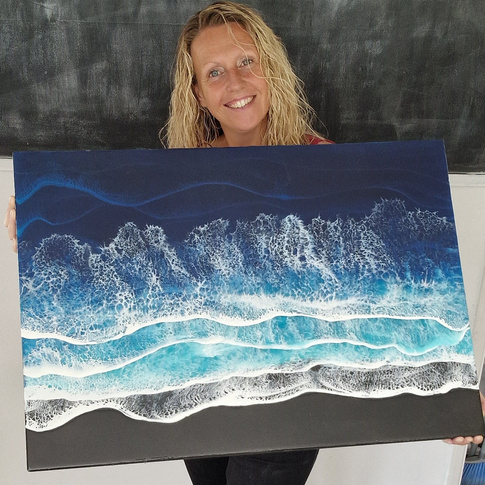
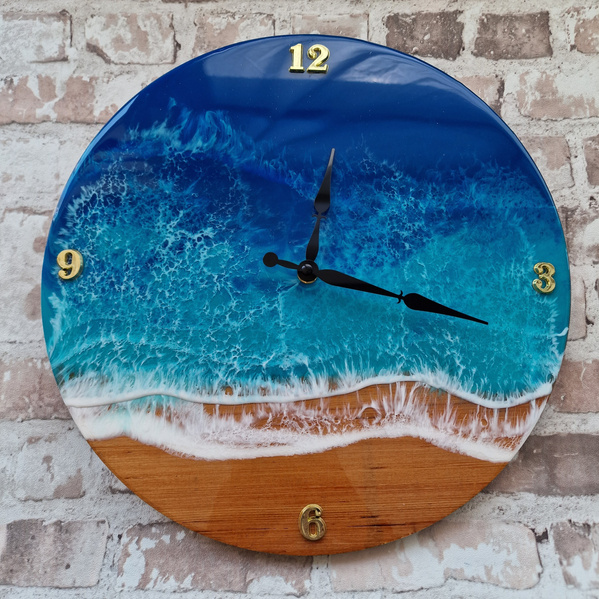
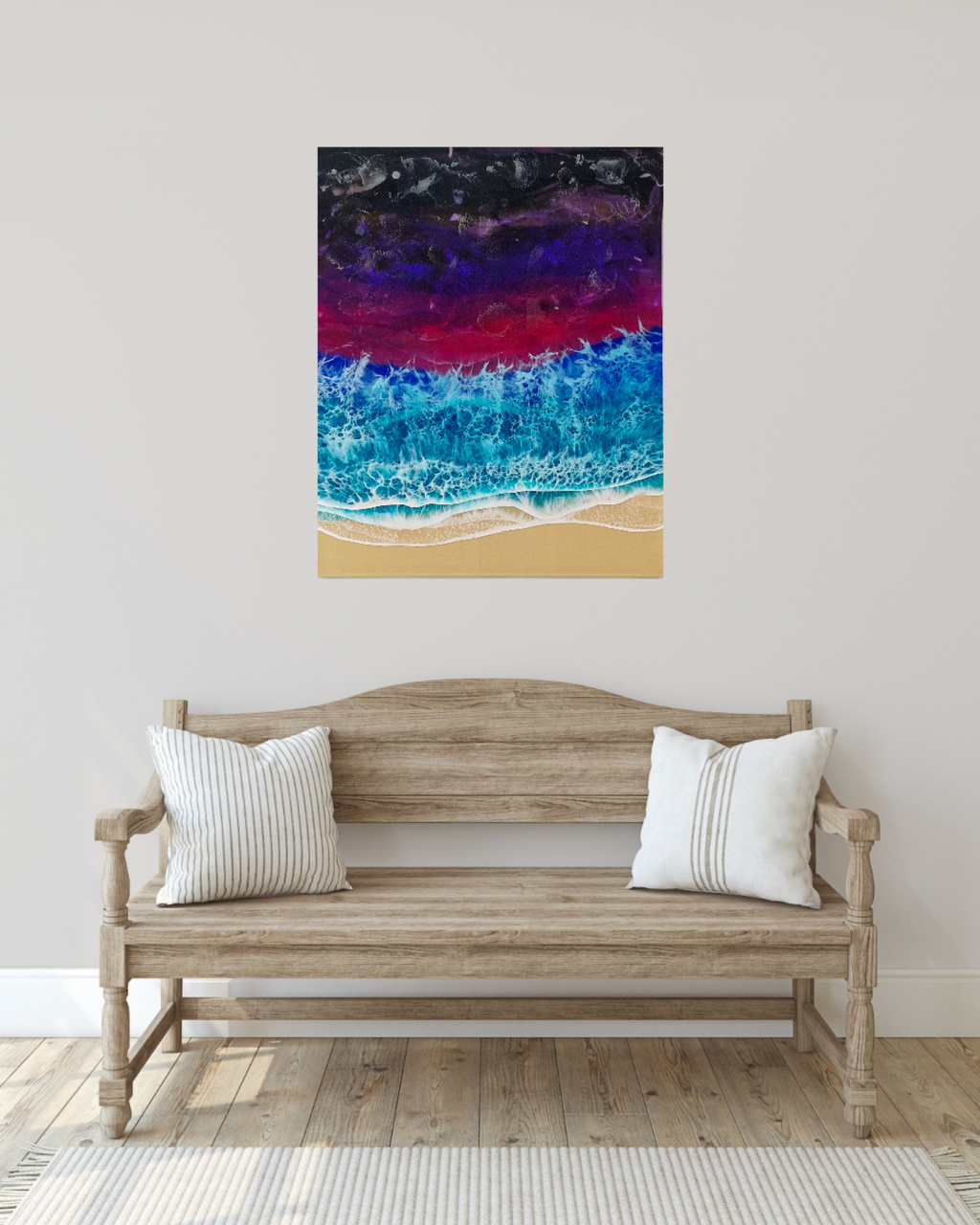
Hollie Jackson
Hollie Jackson, Riboleau Studios, Riboleau Street, Ryde, PO33 2JT - resinartbyhollie.com
The radiance of resin
There was a moment’s confusion when I turned up at Hollie Jackson’s studio. She had been expecting someone to pick up a splashback for an induction hob. The said splashback was all there, ready for its new owner – an orange and yellow swirling abstract - very beautiful, and ready to bring a warm glow to the lucky new owner’s kitchen. Sadly not me for that one. Hollie’s resin art is, for the most part, functional, and she fulfils many commissions ranging from mirrors to memorials. In her studio, I observed a little round hole in the centre of a beautiful circular beachscape - ready to receive the hands of a clock. Necklaces and earrings too are inspired by the breaking waves that surround her island home. The sea runs in Hollie’s veins. “It’s my absolute passion”, she told me. She grew up on the coast and lives just steps from the waves. Sunrise walks on the shore inspire both her beachscapes and abstract work.
“Follow your dreams” instructs a little wooden plaque on her workbench. Whether it’s a functional piece, or art for art’s sake, Hollie wants people who see her work to “get lost in a paradise world…to run away with somewhere beautiful in mind”. Looking deep into one of Hollie’s abstracts, that isn’t difficult to do. They give sparkle to the darkest corner, but when the sun catches them, they really come to life, revealing inner depths and new dimensions, and occasionally a mysterious glint of gold, tantalising the imagination.
Creating the work is quite a technical process, with some pieces take four days, others two weeks to complete. They are made on wooden bases. I noticed some cut-out shapes on the workbench. A seahorse, primed in two colours of matt paint, turquoise for the sea, sandy yellow for the beach, waiting for the application of the layers of resin that will transform them with the movement of washing breakers. Layer after layer are patiently applied, with 24 hours between each coat until, wave after wave, an ocean takes form.
All this is just one aspect of Hollie’s activity. As you find your way to Riboleau Studios, you may well pass other pieces of Hollie’s art (clue: look for a cheerfully-wrapped Wightfibre box behind Ryde Co-op). She is part of the “community murals” team and has had a hand, together with her colleague Emma Goss, in adding an extra splash of sunshine to the town’s streets.They hope to extend this project to involve young people in the work. An experienced teacher, Hollie is also running workshops at her studios, and when she is not busy there, she can regularly be found at her stall at island art fairs, at Chale and Wolverton Manor, the Isle of Wight County Show and the Garlic Festival, offering her customers the chance to take the tang of the sea and an escape into paradise right into their homes. - R.L.
Riboleau Studio is open every day during Ryde Studio Art Trail, 13 – 17 September, 10 am – 4pm.
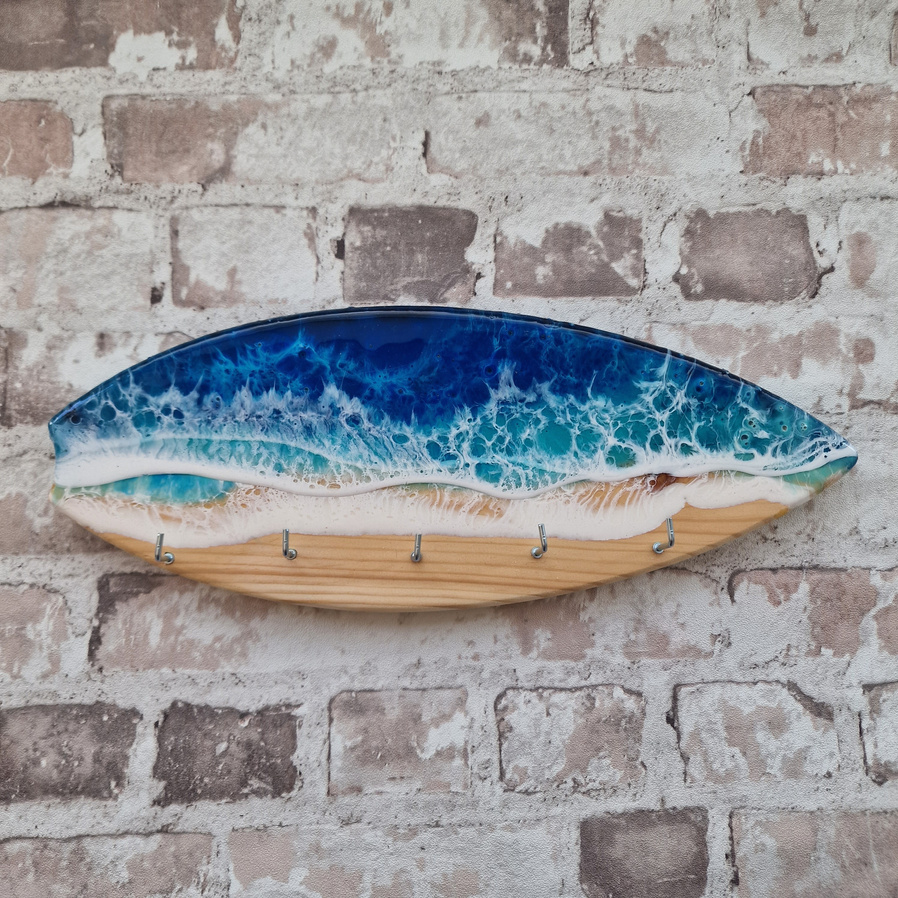
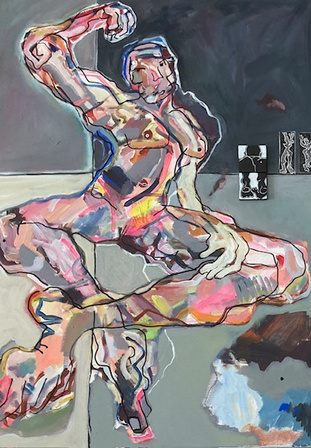
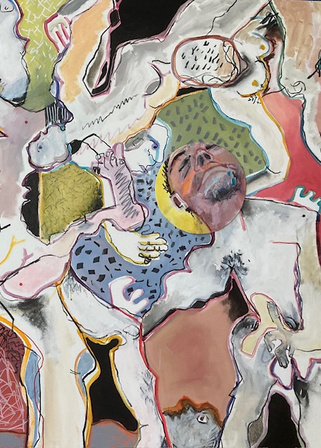
Sandy Kendall
Go figure!
Sandy Kendall’s business card reads: “Professional visual artist and haphazard printmaker”. The haphazard printmaking, for the past six months, has been a relentless experimentation with gelli plates. When she framed and exhibited some of the results at Monkton Arts, where she has a second workroom, the show was a near sell-out.
When she isn’t making prints, Sandy’s work largely involves painting in acrylics… or anything else that comes to hand. She delightedly showed me her latest acquisition, some Tansy Hargan handmade watercolours that came in a vintage tin, and the free, flowing and glowing bon-bon coloured figures Sandy had used them to paint.
“I use every medium except oil paints” Sandy clarifies “they take too long to dry. If I want to change something, I have to do it there and then”. Sandy has a fast-paced high-energy artistic style, following up and intensively researching ideas. “Every medium” doesn’t just cover the conventional artist’s range of materials. self-confessed “incurable litter-bin raider”, Sandy has open on her desk a big book of anarchic drawn heads with mix-and-match features incorporating false eyelashes, bits of packaging “and other trash” as Sandy puts it. If a painting doesn’t work, it gets taken apart and made into something else, for “Everything is recyclable”. I noticed the cardboard base from a packet of peaches that had been turned into a two-minute totem pole, and a piece of driftwood off the beach that had acquired facial features in chalk during an idle moment, as well as piles of sketchbooks full of life drawings. Sandy adds 3D elements to her paintings – a cube here, a jigsaw puzzle-piece there. In a play on traditional tapestries, she has used curtain material as a surface for giant figure drawings to be displayed at an upcoming exhibition at Quay Arts in October.
Sandy’s specialism and passion is as a prolific painter of the human form. Her inspirations range from the classical to the eclectic, Michelangelo, Rubens, Poussin for their sculptural treatment of figures, Robert Rauschenberg for his “Combines” (“urban trash on painted surfaces”), and figures from Greek myths and the Bible, to name a few. All of human culture is here... Circles, the cross, the last judgment and Prometheus are recurrent themes, as are monoliths, eagles, vultures and crows, and always the human body, usually many bodies in a single artwork.
Sandy gives private tuition to adults and children at her studio. Her influence is already apparent in a young student’s charcoal drawing of a mushroom that could perhaps be transmogrifying into a body. As well as being a teacher, Sandy is herself a perpetual student, always eager to hone her own skills, reminding herself of the rules that make for good painting, and taking every opportunity to practise through courses and life drawing classes, though I suspect that most of those rules are well ingrained in Sandy’s subconscious and are there to be had fun with in their breaking. She favours instinct over science when it comes to colour theory, and her confidence in both composition and style are striking.
“What are you thinking about when you paint?” I asked her. “Balance, composition, weight, shapes, tone, looking not just at sections, but the whole piece, by standing back from the work.” There can be no doubt that Sandy is very serious about her work. But her jokey side is irrepressible. I observed in a piece currently on her easel three body parts where only two is normal, one of them detached and falling through space. – “I would rather make people smile than shock them” she says. The true drama in Sandy’s work happens in her tonal contrasts and ambiguous combinations of elements, as well as a dash of mystique. “I don’t want everything to be immediately apparent. I like to leave something to be discovered”.
Planes and levels and layers of meaning, androgynous figures – energetic mark-making, flashes of neon, dramatic contrast in tone and materials were some of my own impressions. I asked Sandy what she would like people to take away from a visit to her studio. “I’d like them to be excited and inspired” came the response. “…with a new awareness of the possibilities --- that anything is possible!” - R.L.

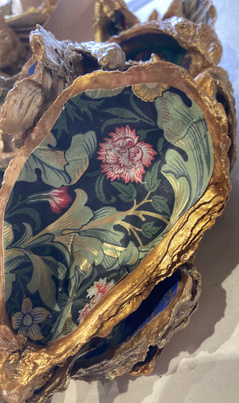

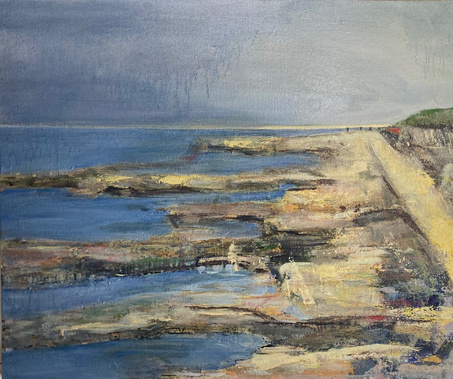
Adele Pearce
Getting at the essence of things
“My work is all about light and colour” says Adele. She paints mainly in oils, but adds other media to the mix “when it feels like the right thing to do”. She listens to her instincts as she works, and her sensitivity to her subject informs her approach. Adele Pearce’s atmospheric Isle of Wight oil seascapes sometimes journey into abstract realism. Sometimes they become mixed media paintings as Adele responds to the mood of the moment.Adele has a wonderful ability to use colour to express the essence of a landscape – and these are not always the colours that you would automatically associate with particular conditions. I was drawn to the hot orange hues in a set of three extraordinary oil landscapes which were started outdoors in wet weather in the West Country. They powerfully evoke the lash of the wind and the bleakness of the north coast of Cornwall in November. This sense of immediacy and intimacy comes from Adele’s own willingness to put herself in personal contact with the elements, and with the land she describes in paint. Adele is rooted in the Island and has a strong attachment to the Cornish countryside.She makes sure that the precious memory of the moment is kept alive and well in her finished work by making initial oil sketches on the spot outdoors before painting on in the studio.
Her family home was on the Island, and it has always been the place she has returned to, though she has moved away for periods in her life. Now she is here to stay. I asked Adele what she thinks about when she is working. “I am constantly challenging myself,” she says “never satisfied, always anxious to move the work forward, and I try to be aware of the point at which it’s time to say finished and leave it alone”.
Adele is also a skilled printmaker. Some of her prints are collagraphs, elements collaged onto a cardboard base then varnished over to form a printing plate ready to be inked up. Others are reduction lino prints. In this process, each different coloured layer of the image is carved into lino and printed before the next colour is carved out and printed in its turn. Often she will also take her oil paintings into print, and then perhaps afterwards work the idea further on in paint again. Adele’s handprinted images are bold and inspired by the natural world – a whale mother and calf swim peacefully together in indigo ink, a lobster looms towards the viewer, claws first.
As well as the deep seas and broad landscapes, Adele is fascinated by details and characters she discovers in the natural world. It is here that her sense of fun really emerges. Gilt-edged oyster shells are scattered across a workbench, beautifully painted each with a unique delicately curling design – seahorses, glistening waves and flowers. On collagraphs and mixed media work, exquisite magpies and ravens, sparking with character, interact with one another, and with delicate teetering towers of china teacups. In another, it is the birds, not the teacups, that are stacked on top of one another.A raven dangles a teacup on a string from its beak, while two magpies perch nonchalantly one above the other, on his head. These lively teacup images have all been inspired by outdoor café life in Bembridge.
Bembridge, with its famous lifeboat station, might well also have provided the inspiration behind Adele’s project for the year ahead. Her new theme is a very exciting one – a body of work depicting scenes featuring every Isle of Wight lifeboat, a project, I imagine that will be both ambitious in scale and full of the drama and adventure of the high seas. On the studio wall, Bembridge again features in an evocative creamy-yellow oil painting of Bembridge Ledge, bony fingers of rock reaching out into a moody sea under a sky lowering with dripping cloud.
Adele is no stranger to adventure. She still enjoys travelling about in her “beat-up old campervan”, often camping too under canvas.She is currently planning just such an expedition and expects to return armed with plenty of sketches from her time out in the wilds, ready to open her doors to visitors on the Ryde Studio Art Trail in September. Adele hopes those visitors will go away inspired to have a go at art for themselves.She is not precious about her work, and she loves to share her enthusiasm for art, especially when she hears visitors say that they could never draw. Adele, an art therapist and professional psychotherapy consultant, knows the healing value of art making and believes that there is an artist waiting to express themselves in everyone. - R.L.
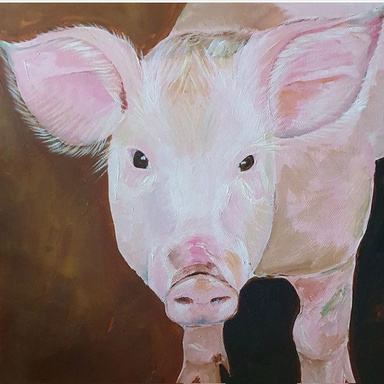
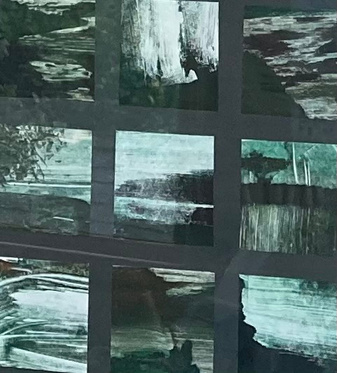
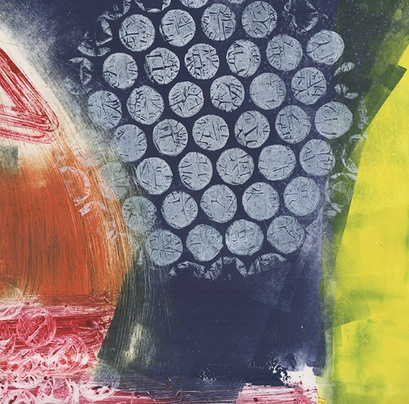
Sara Truckel
Art and the reason for being
Sara Truckel shares a beautiful garden studio in Binstead with Viv Alexander. They spark off one another, learn together, inspire and challenge one another and share a similar sense of humour. There is much laughter in this studio.
Sara showed me her new work as I arrived – A large freeform abstract monotype island landscape divided into nine square scenes representing her island home, and another cut into nine circles. Squares and circles are very important in Sara’s work, but particularly circles. She showed me her “interplanetary” series of molten worlds in swirling soft colours, and fished out a fistful of cards made from prints of circles, broken circles, connected circles. The all-important circle for Sara is our planet. It is Sara’s greatest desire to use her art to raise awareness among her viewers on environmental and other issues we face in contemporary society, and perhaps also to introduce the world of art to environmentalists, for example, who have no artistic background. Her current major project is to investigate the question as to how the message of climate change can best be communicated. The usual channels are the news media, but could art provide a more effective way to get through to people?
Sara is a multidisciplinary artist. Much of her work up to now has been printmaking mixed with collage made in response to her environment, to nature, to songs and to poetry. The walls of her studio are lined with monoprints, a souvenir poster from the Utrecht Kapitaal open-access print studio in the Netherlands, and experiments with cyanotypes are pegged on a line under the ceiling. “Failed experiments”, says Sara, but I observe an intriguing snippet of a letter where just one random line of writing emerged on the cyanotype, and a scrap of lace that had produced a delicate image of itself.
For Sara, it is the message that is all-important in art, and the message dictates the medium she works in. Sometimes she will be drawn to work in 3D. Linocuts of seagrass and seahorses formed the basis of a collaborative community art project she co-led with another Island artist in collaboration with Project Seagrass for the “Seagrass Symposium” held in Cowes earlier this year, helping bring together creatives with climate change and biodiversity experts. The project was to highlight the involvement of seagrass in carbon capture and the importance of its restoration and conservation. Recently, however, Sara has felt the urge to paint, and she has been painting portraits in oils to raise awareness of the plight of animals. Jessica the cow and Ethel the pig were her first sitters – both with birth and death dates alas far too close to one another. An as-yet unnamed sheep is in progress. These, Sara laments, “are sentient creatures, born to die, but for what reason?”
For Sara, art is not merely “for art’s sake,” or “for other people’s enjoyment”; it can be an effective tool to make a difference in the fight against climate change, promoting women’s equality and equality among peoples, as well as the rights of animals. These are passions that burn inside her. Her cow, pig and sheep are all female animals. Most farm animals are females, used for breeding or their milk. She is keen to highlight the injustices of how women’s bodies are used, and how women have been seen throughout history.
Sara is a connector and a collector. She and Viv share a “drawer of interesting things” – offcuts from work, pieces of interesting materials, beautiful textures “I love bubblewrap!”, and many of Sara’s prints are assemblages of images or pieces of images. Mudlarking is not just for the River Thames. Sara has found wonderful ceramic treasures on dog walks through the tidal mud of the River Medina. She has collected and preserved them in a frame, each fragment of a larger piece has become a little work of art in itself, shaped by time, the waves and by accident. Like her squares and circles monotypes, which she describes as a “collection of happy accidents”, this box too is a collection of happy accidents. Each fragment has a story to tell – each a piece of history, and Sara has brought them together. In various projects on the Island, she has also worked with Island organisation Equals IW, a project that brings people together who aren't British natives who now live on the Island. Sara has helped deliver creative sessions on Sandown beach and Culver Down to connect the participants with their surroundings as part of the recent Biosphere in the Bay project, making links and forging connections in the name of the planet.
I asked Sara how she would like people to feel as they walk away from visiting her studio. “When I go to an exhibition,” she replied, “I like to go away with more questions than I went in with, and to be kept thinking for days afterwards, so I’d like for people to come away from my studio questioning things, and questioning their own actions”.
The atmosphere in Sara’s sunny studio is cheerful, the artwork is colourful yet powerful. I suspect that those questions will delve very very deep. - R.L.
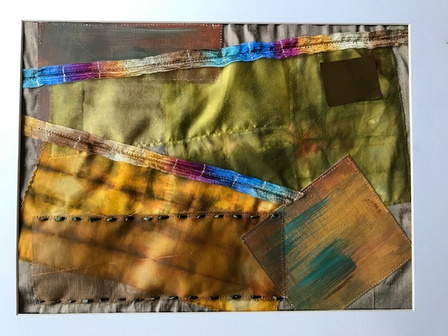

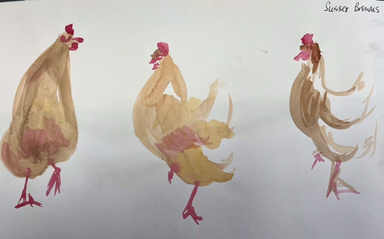
Viv Alexander
Mystery with a dash of Matisse
Viv Alexander – formerly known as the artist Viv Garrett – has changed her name, being recently married.“Perhaps this is a good opportunity to reinvent myself artistically too” she says. In fact, Viv is a life-long learner, and her work is always evolving in exciting new directions, and she and Sara Truckel, with whom she shares a studio, have been on many courses together, most recently one held by illustrator and experimentalist Laura McKendry, which has inspired and informed much of Viv’s current work, and Viv is a devotee of the life drawing classes and courses held by art tutor Nick Martin at Quay Arts.
Viv’s joy in life and interest in people shines through. Like her niece Sara, she uses her art to connect people. A series of Matisse cutouts were the inspiration for some cut paper images for the Island Pilates Centre. They are very expressive and beautiful in their simplicity, and I was not surprised to hear that they had earned Viv a commission for more.
Viv is excited by texture, and fabrics. She has a drawer full of coloured fabrics, threads and bits of ribbon, and these are often collaged or stitched into her work to create exciting and mysterious images.She stitches into her work either by hand or by free-motion machine embroidery, incorporating remnants of monoprints. She uses a printmaking technique known as chine collé, in which tissue paper is torn and applied to textured paper, after which she will roll black ink onto Perspex into which she creates patterns and marks using various improvised tools, credit cards or anything that comes to hand that will make a nice shape, and then prints the resulting textures onto the work. Viv has made a large series of chine collé work, and is revisiting this technique in the run-up to the Ryde Studio Art Trail. Viv takes great pleasure in mark making, texture, colour and pattern. She likes earthy colours, browns and oranges, and enjoys even the “sludgy” colours resulting from mixing every colour to hand, even as tutor Nick’s voice rings in her mind “Just choose one or two!”. After all, that greyish brown contains within it every colour on the palette, and so has the ability to offset, enhance and reflect the brighter tones. It’s all part of Viv’s process.
Viv grew up on the Isle of Wight, and is inspired by its landscape. It is the Island she thinks of when she responds to lines by French poet Charles d’Orléans “Le temps a laissé son manteau” (the weather has laid down its coat) about the emergence of springtime. In her mind the lines of that poem are associated with the view from above Carisbrooke Castle, overlooking the castle and the golden fields beyond, and her abstract piece in rectangles of gold fabric with collage and contrasting stitch is fabulously evocative.
Not all of Viv’s work is abstract. Her sense of fun is obvious in lively watercolours of Sussex brown chickens and a lovely golden monochrome linocut of a mythical running rooster.
I asked Viv, as I asked Sara, what impression she would like to leave in people’s minds after they have visited her studio. She responded that she’d love them to leave with a smile on their faces, having enjoyed themselves thoroughly. There is absolutely no doubt in my mind that they will.
In previous years opening their studio, Viv and Sara have raised generous sums by baking cakes and offering visitors tea and cake for a donation to various charities. As well as having parking on the road outside, they are on a good walking route (see Instagram @rydestudioarttrail for a suggested walk round all the studios on the art trail this September) and parties of ramblers have in the past shown great appreciation for the chance of a studio stop-off in the past. I was certainly welcomed with a warming cup of tea after my wet stroll down Ladies’ Walk in the rain from Ryde, and I wouldn’t be at all surprised if the pair will not be able to resist sharing their baking as well as their artistic accomplishments once again this year – no pressure, of course... - R.L.
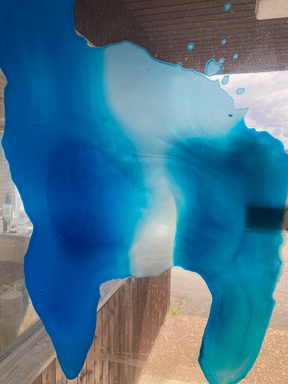

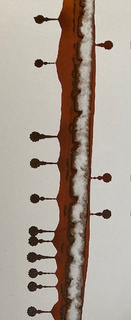
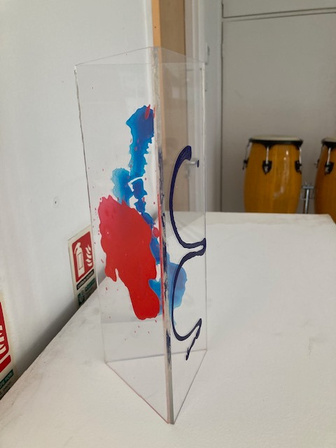
Kathy Williams
Riboleau Studios, Riboleau Street, Ryde, PO33 2JT- www.kathywilliamsartist.co.uk
Capturing a space and a time
Did you see the paint on the walls of the bus shelter at the top of Union Street a few weeks ago? Did it try your patience, or did you see it as an exciting new visual language out on the street? If you visit Kathy Williams’ studio, you’ll learn what it was all about, and come out with an insight into new ways of seeing. Kathy is fresh from her residency in the display window at the former Elizabeth Pack store, now the Department arts hub, Ryde. There she embraced the bus stop outside with its transparent sides and ever-moving backdrop of people, vehicles and urban space, as an extension of her work in the window studio. She is now in a period of assessment and experimentation. The residency has added new dimensions to her ongoing contemplation of space and time. Where will it take her next? She plans to make models based on her window-studio work, and perhaps take some of the developing ideas to different sites, moving along with what she has made, even as she makes it.
Kathy is a painter, but not a painter of pictures. “I don’t ever feel I have an image to paint” she explains. The picture isn’t what she is interested in pursuing, though many of her explorations have resulted in very beautiful series of artworks. Indeed, all of Kathy’s work is intriguing and multifaceted. Kathy’s paintings are about the nature of paint and painting; “paint can say more than you put into it. We use paint because of what it can do” she says. There is always an element of the uncontrolled, and therefore the unknown, involved. Kathy sees painting as a mirror for every aspect of life, from parenting to gardening. “You have some knowledge of what you want to do, how you want things to be, but there is always an element of the uncontrollable. The paint is like that. It talks back to you about what you are doing”. Kathy realises that ultimately, the painter has to allow paint to do what paint does. It seems to me that Kathy approaches not just the paint, but also the painting surface in the same spirit. In several 3D paintings in which painted paper is rolled into a cylinder and adhered to the surface, Kathy is mulling whether to tear away the paper cylinders so that the paper will leave behind traces of itself; allowing the paper to do what paper does, I suppose.
Not a figurative painter, Kathy does see figures in her completed artworks. In knobbed lines of colour in two works, Kathy sees the vertebrae of a spine in X ray. In the same two paintings, I saw a landscape, and a telegraph pole so vividly I wanted to climb up its rungs, for these monochrome paintings, simple as they are, have great power. X-rays too bring the inside out, in their own way.
The theme of inside outside is essentially a coming together of opposites. The bus shelter was decorated with artworks from inside the window studio. The windows and the artworks in the bus shelter reflected the buildings of the street, and their own windows, and the people in the bus shelter sat sculpture-like within, becoming part of the art in their turn – layer upon layer looking out looking in. Kathy showed me the pile of transparent plastic sheets which had been painted at the Department and the bus stop outside, both by Kathy herself and by passers-by who she had encouraged to express themselves in abstract marks. Some of these sheets she rolled into a cylinder. An arch painted on flat plastic became a ribbon bow shape, taking on new aspects with new spaces in between as she moved it around. She has set these cylinders on turntables and she showed me a video of one she had made at home while the television was on in the background. As I watched the video of the circulating plastic cylinder, I was transported to a moment in time and place in my own life - watching a snatch of Christian Marclay’s movie, The Clock in Metz several years ago. The Clock consists of 24 hours of clips from old movies referencing the time in sequence. Kathy’s concept was different, but here too video (the tv) was informing what was going on in real-world time and space, becoming part of both the artwork turning on the turntable and the new artwork being made – the video of it. Snatches of speech and music from the television dictated the entire mood and meaning of the piece in that particular moment. In a different location, the language of the marks would take on a quite different meaning. Kathy expects to show some of these turntables during the Ryde Studios Art Trail. She is interested in the way the transparent drawing, when rolled, “moulds into itself” and the shapes change as they move around, interlinking with one another. She wants to build up these transparent shapes, and is planning some 3D sculptures based on them, and perhaps to make a site-specific, event-specific piece especially for the space at Riboleau Studios.
Kathy plays with opposites, making a flat painting on an uneven surface, for example. She has run workshops at the studio, teaching both the elderly and children simultaneously – people at opposite ends of the age spectrum who turned out to have a great deal in common and had enormous fun together. Previous projects have included giant still lifes of found objects, in which the space created on the canvas is as important as the marks made, as well as meditative drawings in which she seeks to capture a moment in time. She has explored relief painting and making paintings 3D – creating real space in a painting.
As I wandered the studio space, I shied away from taking a photo of one little framed 3D artwork backed by a mirror, not wishing my own mugshot to appear in the photo as part of the artwork – yet another looking inside/looking outside piece.
I asked Kathy what she would like people to be thinking as they come away from a visit to her studio. She was ready with her response: “I’ve got this space, perhaps I could let Kathy do a site-specific artwork for it”.
I was so excited by the conversations Kathy’s artworks had sparked off as we talked together in her studio that I forgot to go scrumping for apples and blackberries in Riboleau’s lovely semi-wild garden graced by a tall and elegant protected tulip tree. When you visit, don’t forget to take a bag with you. I’m sure they won’t mind . - R.L.
Kathy Williams' studio is open Thursday, Friday, Saturday and Sunday during Ryde Studio Art Trail, 13 – 17 September, 10:30 am – 4:30pm. (ground floor, all one level)
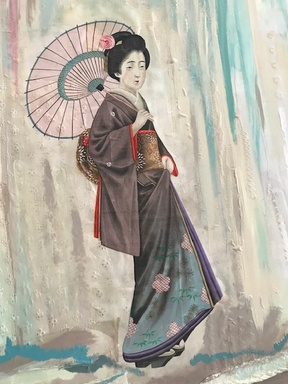
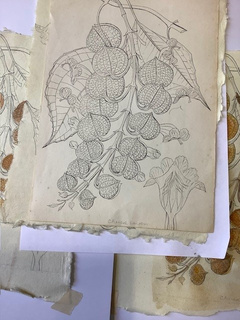
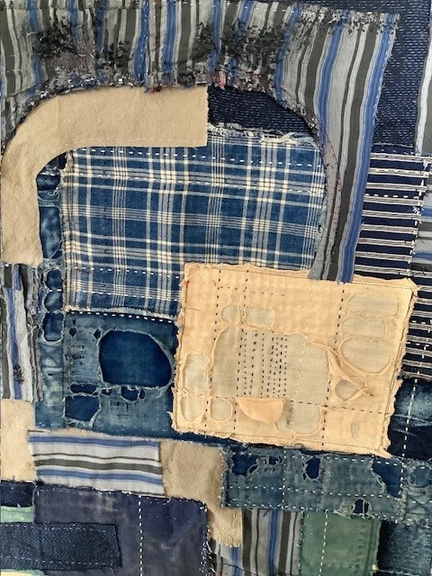
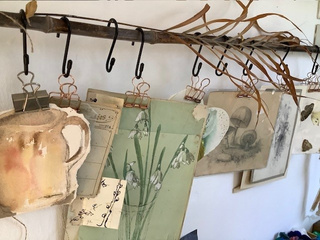
Rebecca Thomas Robinson
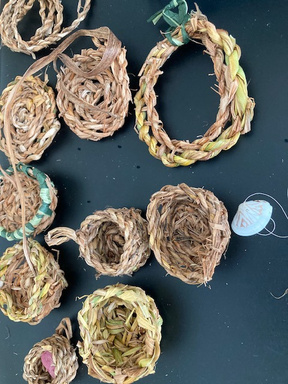
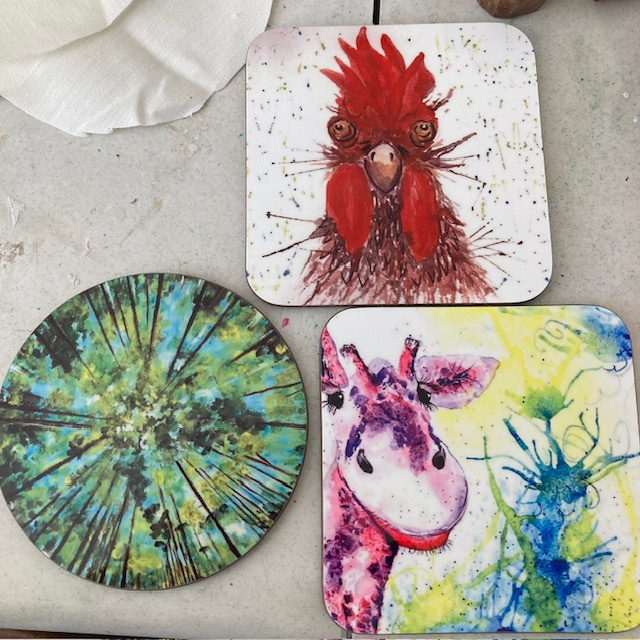
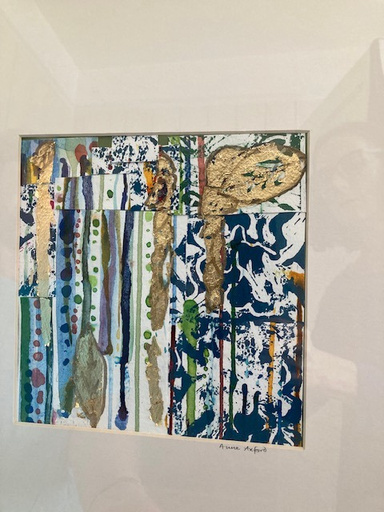
Anne Axford
In celebration of life
When I visited Anne she was happily engaged in some experimental weaving using the long leaves of day lilies. These plants flower for a single day, “but their leaves are extremely strong and, although some people prefer to dry them, you can work with them straight away, as soon as they are picked, which keeps them more flexible” Anne tells me. She is currently twisting strands of these and creating little pots by stitching the strands she has made into coils. Anne had also cut out circles of fine linen to stuff with lavender. She plans to decorate these using Indian stamps or linocut prints to produce small lavender bags to sit inside her beautiful woven day-lily pots.
Anne has found many other practical uses for her artworks, from cards to coasters. She takes inspiration from nature and her surroundings here on the Isle of Wight. She lives just a walk down the hill from the sea, though she is often waylaid on her walks by the shore, and they become foraging trips as she is unable to resist picking up seaglass or shells that she finds, to integrate into her latest art project. Anne finds delight and humour in the seagulls, the pigs at Quarr Abbey and other animal characters she encounters. “People love my funky animals” she says. For Anne, art is about making people smile, and to her, creative activities are pure joy.
Anne has a sunny temperament and looks on the bright side of life, though life has not been without its troubles in recent years. She finds solace and distraction and real pleasure in losing herself in art and “it’s lovely when people buy your work”, she says.
Anne always has new ideas on the go and experimental work to play around with. An enduring passion is for gold leaf and I admired in particular Anne’s abstracts in which she had contrasted the precious gold against scraps of recycled linocut. Anne always has a stash of scraps to dig into when she needs an additional element to her work. “You need a steady hand, and to be quite brave when it comes to working with gold leaf” says Anne. “It can go wrong…and it does!” But Anne has perfected the art of getting the glue at just the right setting point to prevent the gold leaf from creasing.
Anne would like visitors to enjoy her studio and, as they go out, she would like them to feel inspired and happy that they’ve been. “Lots of people have a political message behind their work, some artists like to challenge people – that isn’t me.” Anne’s work is a celebration of the joys in life, and of her own good fortune at being able to live here by the sea, with a view of it twinkling from her upstairs window. Looking around, I see the influence of the sea in almost every picture. Maybe even in the animal ones where it isn’t so obvious - a pig, an ostrich, a blackbird - all share that cheerful twinkle in their eye. “It’s a wonderful place to be” she says. Anne showed me her gold-leaf map of the Island against a simple white background – a celebration indeed! - R.L.
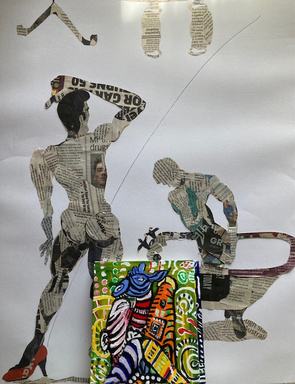
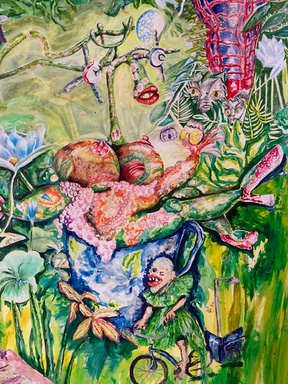
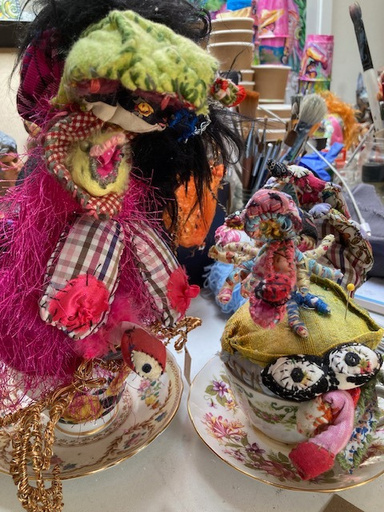
Joshua Raffell
Monkton Arts Studio, East Street, Ryde, PO33 1JP - e-mail: joshuaraffellart@gmail.com
Fragments of survival
I visited Josh at lunch time and his pizza was on the table, cut into slices. The smallest slice had an index-finger topping, while an ear and a thumb garnished the unsliced half. Various other body parts were sprinkled across the clay base – it would soon be ready for the oven, or should I say the kiln. I had entered the surreal world of Joshua Raffell.
Most of Joshua’s art is an autobiographical exploration. His current project is his story of Surviving a Borderline Parent based on his working through of a self-help book with that title by Kimberlee Roth and Freda B. Friedman. Joshua works through his own story backwards, though not necessarily in a straight line. His exploration of being dyslexic and the distortion and confusion it can bring to his own perception of the world, including memories and perspectives on them, shape the unique style of Josh’s art. His canvases, crochet and mosaic work, sculptures and upholstered teacups invite us to join him on colourful romps through his own thought patterns which overspill and populate everything en teeming masse.
Joshua Raffell has received a Turning Point bursary for visual artists from A Space Arts at God’s House Tower in Southampton, for his Surviving a Borderline Parent project which is very large in scale – too large for his small studio at Monkton Arts, and so he has been working on some of it at the Depozitory in Nelson Street. Joshua will show the work at the Acons gallery downstairs at Monkton Arts and at A Space, and is in talks with Studio 1.1 in London about presenting it there. It is part sculpture project, part series of sketchbooks highlighting his own story and his truth and perception of memory, and that of those close to him. “I’m sorry I used you as a punchbag” were words that will forever live with Joshua. They are a mother’s words to her son. A real punchbag is in the process of becoming part of the sculpture work for the project, also incorporating mosaic and – who knows – perhaps performance.
Joshua has received the Isle of Wight Creative Network bursary. For this bursary he is making a work based on the novel “Pig Tales” by French writer Marie Darrieussecq. He acquired it as part of a ‘blind date with a book’ scheme operated by Babushka Books of Shanklin. It is the story of a female escort worker who turns into a pig and falls in love with a man who turns into a wolf. Under the full moon, they order a pizza. In the novel, the wolf kills the pizza deliveryman and the couple share him on their pizza. As Joshua told me this, I had a flashback to the sketchclub Joshua used to run on a Monday in the café at Monkton Arts. Dismembered dolls were often a feature of the idiosyncratic still lifes Joshua would set up for us to draw. These, the kiln-ready pizza on the table, a figure, part woman, part pig - things suddenly started to fall into place in my mind. At this point, perhaps you might be thinking that I should have made a bolt for the door. But Joshua is lovable and full of humour despite the crazy imagery, and I have to say that I was drooling for more.
“What’s that?” I asked, diving under the desk for a fantastic set of swivelling ‘misfit’ self-portraits made from paper beakers that had caught my eye. I stared mesmerised, too, by a high-octane dreamscape on canvas in which the faces of Joshua, his partner Dave (at one point merging into an Orkney Island puffin), and other characters from Josh’s life and memories swim, cycle and frolic through meadowlands, accompanied always by a liberal smattering of gay erotica. Josh doesn’t shy away from the graphic image yet everything is done with a rumbustious sense of humour and so much colour and life that you cannot help but love the work. Scrolling through my own phone gallery of images snapped while doing this series of interviews with artists, Joshua’s stand out for their vivid variety and energy.
A vignette within a dreamscape of the artist riding a bicycle in a green ruffled frock reminded me of Grayson Perry. Joshua has met Grayson who surprised him by admitting “You scare me” – perhaps Grayson, himself not a conformist to perceived ideas of how people are, had been challenged by meeting his match. There is certainly a defiance in Joshua’s work. In another dreamscape, a teddy is being decapitated by a large sharp pair of scissors – Alan Measles beware!
Although Joshua has, as he put it, “been through the system”, acquiring his BA and Master’s in fine art, he admits to leaning more towards outsider art. For him it is important not to get too caught up in the right way to do art – “you just need to be doing it”. That is how he approaches his own work. He will start with an idea, provided by a book or an episode in his own life, and in doing the work, the relevance emerges – stories evolve along with the work. One example is a large work on cardboard devoted to Joshua’s search for his father. His storybook character travels around meeting people from different countries “I wish they were my dad”. I will leave you to find out what happens next.
I asked Joshua how he would like people to feel as they go out after visiting his studio. “I want to make art that is accessible to people, and I don’t want to tell people how they should read my work…but people don’t always find it easily accessible“ he said, “I’d like people to come in with an open mind, or if they haven’t come in with an open mind, that they will go out with one”. As Joshua’s first Ryde Studio Art Trail visitor, I came away with a head full of colour, stories and impressions. People definitely shouldn’t be afraid to enter Joshua’s uproarious world of art. Storms and disruption there definitely are here, but there is release and joy in the uproar and the tempests swirling upstairs at Monkton Arts, and they are, after all, tempests in a teacup. - R.L.
Joshua Raffell's studio is open every day during Ryde Studio Art Trail, 13 – 17 September, 10 am – 4 pm. (steps to studio)
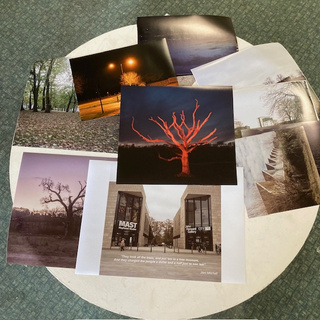
Jim Elston
Riboleau Studios, Riboleau Street, Ryde, PO33 2JT - www.jimelston.com
Darkness for seeing by
“7b Jim Elston – Fine art photography” says the art trail map and flier. I anticipated being dazzled by technical prowess, with perfect beach scenes, Solent sunsets, long-exposure water tumbling onto rocks or soft-focus black-and-white moody prints of beautiful people against an ocean backdrop… Beautiful images I did see, and no doubt evidence of technical mastery. But I did not anticipate being moved to tears, or having my entire outlook being challenged and changed on, for instance, what is a tree, and indeed what am I. The story Jim Elston has to tell us through the medium of his camera lens is emotionally powerful and could be transformative. But we began our conversation with his own artistic journey.
After a career in accountancy, the creative urge finally took over and Jim, a talented guitarist in his spare time, escaped the corporate world to tour with a band, and still plays with his band “Mark III”. After suffering multiple heart attacks and several rounds of surgery, Jim bought his first camera to give himself a creative outlet and an incentive to get outdoors and restore his mental and physical equilibrium. “I hope this isn’t going to be a five-minute wonder!” He laughs as he recalls the words of his wife Julie, known as Ruby. But a schoolboy interest had been reawakened and Jim embarked on a BTEC in photography at Isle of Wight College, followed by a BA at Solent University. At his graduation ceremony, he was surprised to receive not just his degree certificate, but also the Christian Drane Memorial Prize awarded to one outstanding student each year. Jim has now applied to do a PhD looking into the “Effects of creative arts study on physical and mental health in later life”.There is, in fact, growing evidence, Jim explains, that creative studies can delay the progression of Alzheimer’s disease.
Not just a five-minute wonder then, and Ruby soon found herself supporting, encouraging and assisting in Jim’s around-the-clock outdoor photographic exploits. She was there with him, for instance, out on the Duver at 10 o’clock one dark cold February night, helping him to set up strobe lights and red gel filters to shoot a lonely tree on film – an image of spectacular impact. Jim’s photography has become the creative passion of his life, and is his means of communicating, from here on the Isle of Wight, a unique perspective on the most vital issues that face us all over the world today, the role we play in them, and what we as individuals can do to mitigate the impact of humanity’s actions.
Jim showed me images of a lightning-struck tree, isolated from its kind above Quarr Abbey, reaching out in vain for company and kinship, the aforementioned lonely tree on the Duver, its network of bare branches perhaps calling out to the network of blood vessels in our own hearts and minds (we share about 50% of our DNA with trees, as Jim pointed out), a tree sandwiched between high-rise blocks of concrete on a Southampton street, another tree stranded on a patch of urban green in Newport, with only the chain-link fenceposts for company, posts that somehow seem to lean with it in sympathy. I will never look at a tree in the same way again. The question arose in Jim’s mind as he photographed these individuals “Do they know they are on their own?” In searching for the answer, he came across the University of British Columbia’s Professor Suzanne Simard’s studies that revealed that indeed they do. In one experiment the researchers had injected carbon gases into a tree to trace where they went, and found that the tree was pumping nutrients specifically towards its own offspring. Some of Jim Elston’s photographs show the stark discrepancy between what the world needs and the existing reality. “It takes 7 – 8 mature sycamores to provide enough oxygen for a single human being to survive” he tells me, but in Southampton, he notices blocks of flats housing one and a half thousand people have an allocation of just four trees. Jim’s evocative photos of the petrified forest visible at very low tide in Compton Bay and a dinosaur footprint near Brook Chine are a stark warning of our own future if humanity continues on its current course.
Jim’s walks around Southampton take him through green spaces, “but no trees”. When he walks across Culver Down and looks across the Solent at dead of night, not only Portsmouth city, but Seaview village is all lit up.Yet migratory birds and the insects they feed on need the darkness of night to navigate. The diurnal and sleep patterns of birds are disrupted by such twinkling scenes, pretty as they may be. It was this particular image that had the deepest impact on my mind.
Jim Elston wants to use his camera to record and monitor what local authorities are doing in response to all these issues. He has plans for a walk along the waterways through Leeds, Liverpool, Manchester, Derby, Nottingham, Birmingham, London and Portsmouth, and will look at how cities have approached urban forestation, adopted in response to the Climate Change Committee’s recommendations. He watches with interest the application for International Dark Sky Park status for the Isle of Wight.“What does it mean to be a UNESCO Biosphere Reserve”, he asks, “when 90% of visitors to the Island arrive by car and when dark skies and biosphere are advertised to attract more visitors? Is this sustainable?”
I asked Jim how he would like people to feel as they leave his studio. He replied that he would like them to go away with the desire to find out more, and to start asking questions of the authorities who need to be engaged with the issues he highlights in his work, issues that are really important to us as human beings. “I would like to remind people that those authorities are reliant on their votes, and that they should ask them what they are doing. If my work has achieved this, then I’ll be happy.” - R.L.
Jim Elston's studio is open every day during Ryde Studio Art Trail, 13 – 17 September, 10 am – 4 pm. (ground floor, all one level)
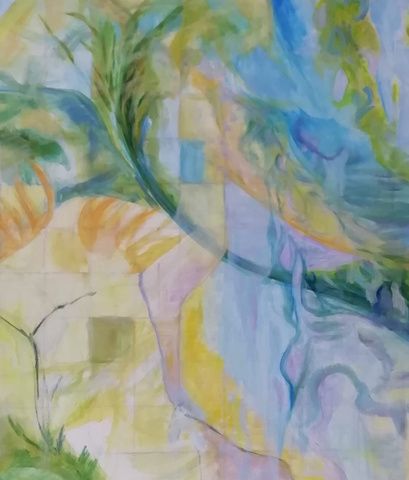
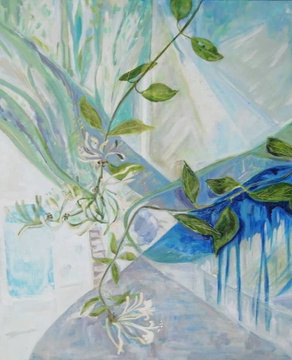
Rai Barker
5 East Street Studios, Ryde, PO33 1JB - 07986 767811
Grounded in the ethereal – sit, see and feel
Rai doesn’t like to walk on concrete paths. She prefers woodland and the feel of the soil under her feet. When I first met her, she described her work to me as “dirty colours” – I would describe them more as earthy - browns, russets, oranges and delicate blues. Whenever I visit her studio, there are always trailing leaves, rosy apples, Chinese lantern and honesty pods, vivid splashes of red geranium or blue hyacinth from her much-loved garden. These colours migrate onto Rai’s canvases which are both grounded in the earth and ethereal at the same time. Delicate, richly colourful still lifes merge with dreamlike scenes inspired by fantasy and moments of memory.
A life-long artist and a yoga teacher, Rai’s spirituality is evident in every painting. The brushstrokes are slow, careful, meditative and the treatment is sensitive. Rai paints in oils and acrylic, large ambitious canvases and exquisite smaller works onto wood. Wood is the surface Rai prefers to work on. “I like the fact that it doesn’t move even when my thoughts aren’t still” she says. A surface to paint on, paints, brushes and “buckets of tea” are all Rai needs to practise her art, she tells me. I would add to that list an inquiring, studious mind and a desire to see beyond.
Painting, like meditation, Rai tells me, is a way of accessing and exploring her own feelings. “Painting can be really joyful, though not always. But it is always an emotional experience, and can be almost blissful”.A large part of that joy is to be found in the simple act of mixing colours. “I very rarely use paint straight from the tube” she says “I don’t even use much pure white”. Rai takes great pleasure in the discovery of how particular colours are arrived at, as well as the combinations that go to make up a particular hue in nature. She has a keen eye for detailed observation, noticing often that the colours that are in the flower of a plant are also present in the leaf. Rai is interested too in the ingredients the first painters used to make a particular hue. “There is something almost magical about colour mixing – actually, it’s mind blowing!” Rai’s colour choices are instinctive, but she reflects on and questions those choices: “Yellow keeps popping up in my current abstracts. I love yellow, and I’m finding myself using a lot of it, but I wonder why. I use it rarely or sparingly in the garden, but I do like it on the canvas. I am using light colours now, which is surprising me and is a change – predominantly pale yellow, pale orange and pale lilac.”
The element of magic has always been present in Rai’s choice of subject. “I see things in the everyday that aren’t necessarily there” she says.“Perhaps it’s a denial of reality, but I will always put something from my imagination into a realistic scene”.
I asked Rai what she is working on currently. “Last year I made a series of abstracts.” This abstract phase seems to have taken her by surprise. “At the moment I am still influenced by that, but it isn’t what I have always done and I wasn’t planning at all to be an abstract painter. These abstracts just floated in so I followed the brush around the canvas” she says. Usually I would do loads of sketches and pick those that could be paintings. Right now I am trying to get in touch with what I want to put on the canvas in future – I’m sitting and seeing”. It is that vital part of Rai’s process – her ability to sit still and to see – that lends all Rai’s artworks their gentle attention to detail and dreamlike quality.
I asked Rai a final question; “How would you like people to feel as they go away from a visit to your studio?” “I like people to feel something”, came the reply, “I would like people to feel anything actually…or perhaps, rather, I would like to have made them think or see or wonder about something in a way they perhaps hadn’t before, and to be open to the magical that exists just behind or alongside the everyday…because it is always there – vibrating alongside the impossible-ness and the apparent ordinariness of the moment”. - R.L.
Rai Barker's studio is open Thursday, Friday, Saturday and Sunday during Ryde Studio Art Trail, 13 – 17 September, 10 am – 4 pm. (access to all)
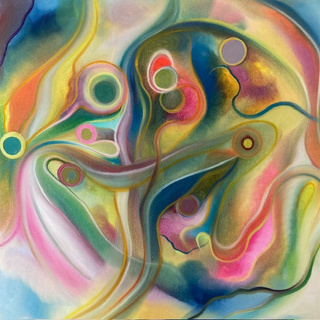
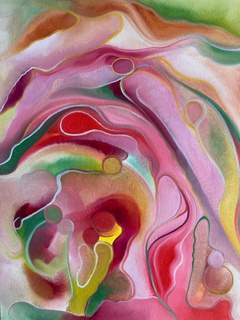
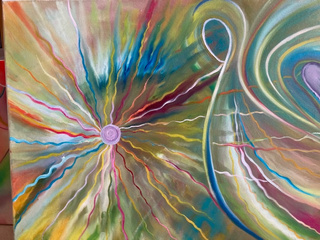
Anna Fauzy-Ackroyd
Riboleau Studios, Riboleau Street, Ryde, PO33 2JT - www.creatingconnections.blog/my-artwork
Spiritual energy on canvas
Anna Fauzy-Ackroyd first started to paint in 2012 after she visited an event at the Oracle Gallery in Godshill. Inspired by the work of Isle of Wight artist Nicola Gibbs there, she felt a deep urge to paint in a freely expressive way. When the opportunity to take part in a workshop held by Nicola Gibbs arose shortly afterwards, Anna jumped at the chance. “I started painting and I couldn’t stop”. She began to paint in oil on canvas using her bare hands, moving the paint around with her fingers. Most of her paintings up to now have had a smoothness to them, but recently she has found herself making dabbing motions with her fingertips to create a more textured surface.
Anna confesses to having no ability to paint representationally, which I think has in fact been an asset to her work, as it has given her total freedom of expression without the awkwardness of trying to force figures to appear on the canvas. They more often than not come unbidden as Anna paints and nothing stands in the way of their emergence. Often these resemble spiritual beings and Anna feels that to work as a painter for her is to channel the spiritual realm.
“I never have any preconceived ideas of what I’m going to paint. I paint oil on canvas and my colours tend to be vibrant”. All Anna’s works are completely abstract, but often she will acquire a “knowing” of what a painting is about as it is being created. She picked out, on different canvases, for example, a figure in a doorway holding a ball, Jesus looking at creation, angelic figures. She also has an awareness of when a painting is not yet finished and needs something more added to it.
Anna paints usually in three-hour blocks without stopping, usually at Nicola Gibbs’s studio once a week. Her paintings have a very distinctive style, but she would not be able to replicate any particular painting because, she confesses, she has no idea how she does any of her work. There is a sense of the cosmic to them, a sense of the elemental, and of a gentle swirling movement of something that is rather lovely - “I think they are perhaps subparticles”, Anna suggests.
Anna has no subject matter and no desire to paint a particular idea. She has no plan. The colours are not pre-mixed, but are mixed on the canvas. Although Anna’s art has no message or subject matter, it is interesting that she herself is an activist and doing art has brought her into contact with other artist activists. She has dedicated several collaborative art exhibitions to the causes she supports relating to injustice and persecution, also reaching out with the screening of a wide range of films, for example at the Commodore cinema in Ryde. She sees an indirect link between art and activism, and has overlaid canvases inscribed with political messages with her own free-expression painting. She is also convinced of the interconnectedness between art and film, literature, and music.
I asked Anna how she would like people to feel when they leave her studio having seen her work. “Uplifted, inspired, energized – inspired by the lightful energy of the paintings. I would like them to go out feeling peaceful, having experienced the beautiful colours and patterns” was her reply. - R.L.
Anna Fauzy-Ackroyd's studio is open every day during Ryde Studio Art Trail, 13 – 17 September, 10 am – 4 pm. (ground floor, all one level)
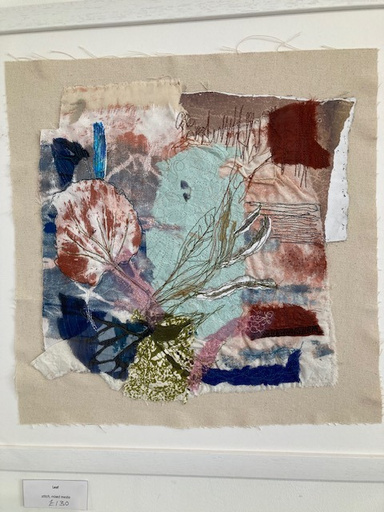
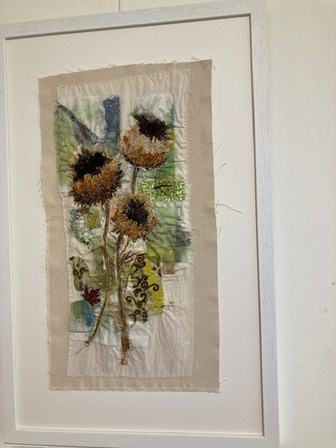
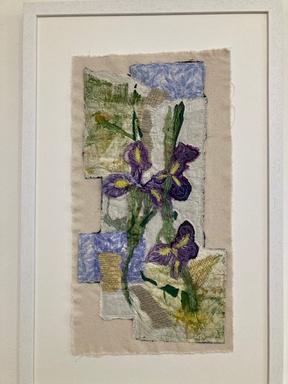
Jacqui Adams
Stitching flowers over bad news
Jacqui Adams won the Monkton Arts prize last year for her work inspired by the story of her mother’s survival at 14 years of age after a bomb dropped on her grandparents’ house in a predominantly Jewish area of London during World War II. Part of her prize was an exhibition at Monkton Arts for which she developed this theme, investigating her mother’s story using family memories and memorabilia. Researching the work has intensified her interest in her own history and in storytelling. “Winning the prize was a real thrill and triggered an outpouring of ideas” says Jacqui.
Jacqui had long wanted to do a piece of work about her mother’s experience, her resulting mental illness and the impact this had on the family when she was growing up. Her mother had kept telegrams, photos, snippets of her grandmother’s handwriting, never shared, and these have been incorporated into mixed media works using printing, stitching and drawing to tell a story of survival, of the lives of refugees and of persecution, and the power of family secrets.
The work in ‘Fragments’ also addresses the possibility that her mother experienced survivor guilt and PTSD and at one stage the research triggered panic and anxiety in her.
This is the back story leading up to Jacqui’s new work which she will be showing during the Ryde Studio Art Trail and it too deals with the process of healing. The series was sparked by criticism in the media when Gary Lineker compared the Government’s asylum plan and the language used by the current Home Secretary relating to refugees with language and policies “used by Germany in the ‘30s”. If you visit Jacqui’s Binstead studio on the Art Trail, you will walk through her garden to find her and you will see its influence in every aspect of her work. For Jacqui, flowers represent healing and the laying to rest of negative feelings.
This new series of work is full of optimism. Snippets of bad news from the press are stitched with fragments of paper and fabric, using hand and freestyle machine stitching. The colours are soft and earthy. There are irises, leaves, seed pods and roses. Here and there amidst the vegetation, we can glimpse an inflammatory word or two: “Boris”, “Gove”, “disinformation”, “Brexit”, “cancer”, “…poured into our rivers”.
Wet felting is another of Jacqui’s passions and there will be small wet felted bowls, some embellished. Seeds are important, not only in producing Jacqui’s lovely garden, but in Jacqui’s thought processes. She talks of the “seedling of an idea”, and she plans to embark on a series of images using seed packets.
I asked Jacqui what she would like people to take away from a visit to her studio. “I would like them to feel hopeful and optimistic. I would also like them to feel that they can do a piece of work themselves. You don’t need a studio to make art,” she says. Jacqui likes to think that her work can help inspire people to work through some of their own grief and hurt. We hear bad news every day. It is unavoidable, but processing the bad news through art “enables us to put a distance between ourselves and the awful things that happen”, and with each mark that is made, each fragment joined, each flower that emerges, a new step is made towards releasing hope for healing. - R.L.

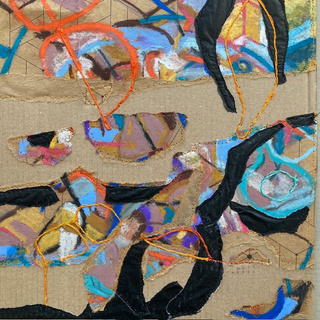
Rosemary Lawrey
The Journey of Shape
Nestled away at the top of Ryde town is the studio of abstract artist Rosemary Lawrey. I had the pleasure of meeting Rosemary last year at another open studios event, and browsed her work and workspace for the first time then. I came away inspired by the collection of works and the way in which Rosemary spoke of her local inspirations. At that time she had completed a series of paintings on the shops at the top end of the High Street. I remember in particular the ones she had made following a trip to the Polish food store, fascinated by the labels and packaging and the products within. Her work now is no different, drawing a continued influence from her surroundings and clear love of Ryde.
In preparation for the Ryde Arts Trail, I had the pleasure of chatting to her again in her bright and spacious studio. Surrounded by works new and old and halfway in-between, there is a sense of an artist full of ideas and commitment. Her current projects focus on the Solent and on horses, and contain her usual striking blends of colours. It is therefore to my surprise that Rosemary informs me that she chooses her palette last, settling on shape first and being directed naturally from there.
On the note of shape, I encourage all to browse the various sketchpads that Rosemary takes on her travels. For these contain the clearest window into her thought process, her beautiful linework which tracks the movements of the things she observes out and about, from people as they hurry around to the waves of the sea as she sits and contemplates their movement and their journeys. For ‘journeys’ is a common theme here, a fascination that is reflected in the stitchwork that Rosemary has taken to pairing with her abstract paintings. Rows of thread track across the painted surface, plotting step-like movements and bringing questions and consideration to the viewer; who took the journey? What for? Was it a worthwhile one? A successful one?
Not just satisfied with the two-dimensional form, Rosemary showed me a sculpture made of glasses, eyewear being another fascination and recurring theme of hers. However, these glasses were not just found or purchased glasses but those of her relatives, adding a personal and emotional layer to the piece. As she talked me through the process and the meaning she commented on the “confusion of the reflections” as the various lenses overlapped as they stood above one another, adding depth, both psychic and figurative, to this piece.
We sidestep off topic onto the charming buildings opposite her studio and I comment on the history she has present before her to inspire. It is then that, with a heavy heart, Rosemary advises me that there are proposals brewing to replace the years and years of history with yet more ‘newbuilds’. Objections are being lodged as we speak and she intends to strongly lodge hers. Yet perhaps this isn’t a sidestep, perhaps it is another link to the ‘journeys’ mapped so well in her works, perhaps this is a moment to allow the journey of those historic bricks to remain standing, to continue to tell their story in some form or another, be it vacant or used in a more respectful manner - perhaps an antiques barn or gallery space, for isn’t everyone and everything on a journey, yet some of us are just not able to articulate it as well as Rosemary in her works. - G.B.
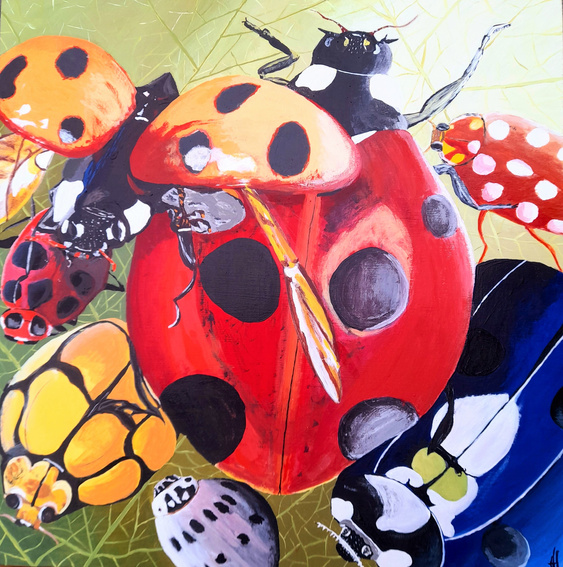
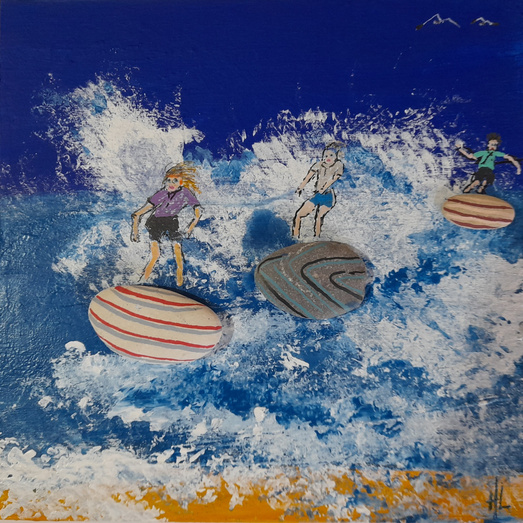
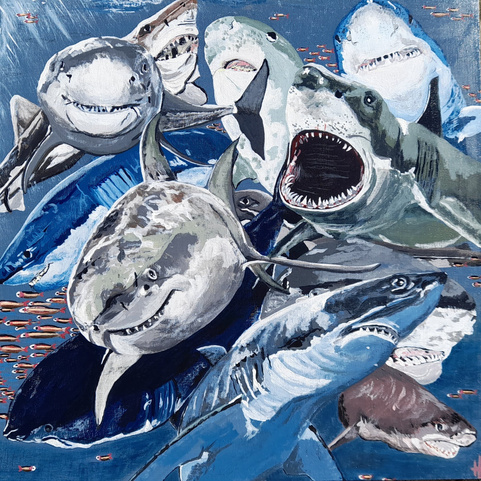
Hilary Love
Candyfloss and sandcastles - with a shiver of sharks
Hilary’s garden studio is bright candyfloss pink – the perfect setting for her imaginative and fun-filled work.
Hilary Love is an artist and illustrator. After her own children’s verse books “Where does the moon go?” and “Where did my donkey go?” she is currently working on a commission to illustrate the words of another children’s author. One of the best parts of writing and illustrating a children’s book for her, Hilary tells me, is travelling around the countryside in search of the subjects she needs to paint – “I need a chicken!” or “I need a barn!” or “I need a donkey!” she will say, and off she will set. She recalls driving all over the French countryside in search of the required items. “I like to be up-close and personal with my subjects” says Hilary. The ten illustrations for this most recent book project have taken her two months to do, painting every afternoon for three hours. Hilary is already planning her next book “Where did my dog go?”, imagining in verse what her black Labrador gets up to when he is left to his own devices and his owner’s eye is not on him. These books, aimed at four to seven-year-olds, are enchanting and fun bedtime reads and are designed to engage both adults and children together in a search for the donkey or the discovery of what actually happens to the moon when we can no longer see it.
When she isn’t illustrating books, Hilary loves to paint on canvas, on wood, and on stones from the beach. She is known for her stone art with mandalas and colourful images painted on smooth pebbles. Her current stone art project is of a different kind, incorporating pebbles into painted abstract scenes. Usually these relate to the seaside. The stones might form the body of a bird or the boards of surfers. Hilary has always painted on stones, and she has found this is a new and fun way of integrating stones into her practice. She recently completed her most challenging stone art project so far on a very large beach stone. Onto it she painted her entire family building a sandcastle together, framing the finished piece with sand and driftwood.
Hilary does most of her planning in her head “I’m not good at sketchbooks" she says. She will lie in bed at night designing her next painting. Actually starting to paint is “always scary”, but she follows the advice of CVP course tutor Californian Nicolas Wilton, always to leave something on the painting that you don’t like when stopping for the day, so that there is something to go back to that you know needs working on the next time you pick up your brush.
Hilary is not afraid of a challenge. If a piece of work is not going according to plan, she will persist with it until it does succeed. She loves to stretch herself and to experiment, trying out different processes. “I have the determination of a Jack Russell” says Hilary. “I don’t give in on a project, even if I have to rip it to shreds in the process of getting there!” In fact, she finds art to be therapy – having faced several long-term health issues, she says “art makes me feel normal”.
Many of Hilary’s subjects are animals: a bull at Quarr Abbey, a ladybird which emerged from an unsuccessful painting of her Labrador, a snail surrounded by swirls and spirals, a shiver of sharks and a pod of whales; “painting several together is much more interesting than just one animal on a canvas”, says Hilary.
I asked Hilary how she would like people to feel having visited her studio. “I would like people to remember me and to come back if there is something they would like me to create for them”, she says. “At the same time, I like to make people think.” In challenging herself, Hilary is not afraid to challenge others with her art. She thinks in particular of a work she made that makes her family uncomfortable but is in fact one of the pieces she is most proud of for its power. The painting is of an elephant. All seems serene and normal on the right-hand side, with lush grass and other members of the herd. However, as we move to the left of the image, there is bare wood and burnt ground, and the head of the elephant itself is turning into a skull. Hilary has built up the elephant's head using layers of moulding medium, giving it a skull-like feel and texture. This piece is a reflection on the cruelty of the treatment of elephants held captive until old age before being released to die in some countries. There are references in it too to climate change and humanity’s disregard for the natural world.
As Hilary spoke to me about her art, she became more and more animated. I could tell that for her, art is therapy and healing, and her greatest passion. I know she is looking forward to sharing that passion with her visitors on the Ryde Studio Art Trail and that her guests in the candyfloss pink studio will find plenty to delight, and to cause them to reflect. - R.L.